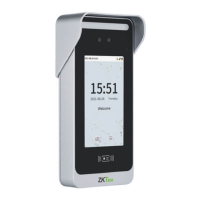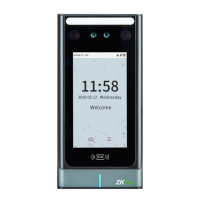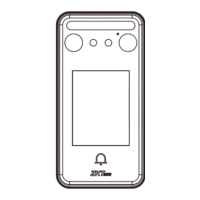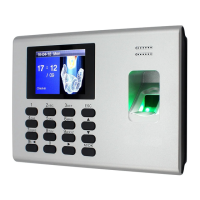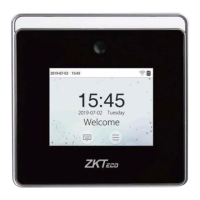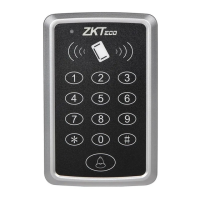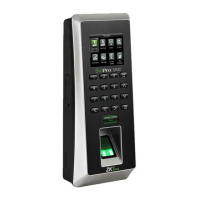Do you have a question about the ZKTeco SpeedFace Series and is the answer not in the manual?
Instructions for correct finger placement on the fingerprint reader.
Describes the initial display after powering on the device.
Details the on-screen keyboard functions and input methods.
How to customize the device's visual appearance.
Explains how the device performs facial recognition for verification.
Details the process of verifying users via fingerprint scanning.
Explains how to verify users using a password.
How to verify users using a card.
Using multiple verification methods for enhanced security.
Step-by-step guide to registering a new employee.
Entering essential details for a new employee profile.
How to capture and assign a photo to an employee record.
Selecting and registering primary verification methods for users.
Assigning user roles (employee/administrator) and their privileges.
Configuring the combination of verification methods for users.
Setting access rights and time zones for users.
How to locate specific employee records on the device.
Modifying existing employee information.
Removing employee records from the device.
Creating new custom attendance status entries.
Modifying existing custom attendance status entries.
Removing custom attendance status entries.
Setting parameters like door delays, sensor types, and verification methods.
Defining time schedules for access control.
Setting special access times for holidays.
Querying attendance logs by employee ID or name.
Finding recorded employee photos.
Searching for photos of individuals on a blacklist.
Creating new alarm events with specific times and sounds.
Modifying existing alarm settings.
Removing configured alarm events.
Configuring network connectivity options.
Setting up wired network connections.
Establishing secure communication links with external systems.
Setting the device's current date and time.
Customizing how dates and times are displayed.
Configuring parameters related to attendance and access records.
Setting how attendance statuses are managed and displayed.
Managing rules for auxiliary device functions.
Configuring when and how photos are taken and saved.
Configuring parameters for user verification processes.
Setting validity periods for user accounts.
Configuring connectivity to cloud services.
Configuring Wiegand communication protocols.
Setting up Wiegand data input parameters.
Setting up Wiegand data output parameters.
Adjusting screen timeout, theme, and wallpaper settings.
Configuring volume and sound prompts.
Fine-tuning recognition thresholds and parameters.
Performing automated tests for device components.
Accessing options like language and factory reset.
Displays device information, capacity, and version details.
Instructions for correct finger placement on the fingerprint reader.
Describes the initial display after powering on the device.
Details the on-screen keyboard functions and input methods.
How to customize the device's visual appearance.
Explains how the device performs facial recognition for verification.
Details the process of verifying users via fingerprint scanning.
Explains how to verify users using a password.
How to verify users using a card.
Using multiple verification methods for enhanced security.
Step-by-step guide to registering a new employee.
Entering essential details for a new employee profile.
How to capture and assign a photo to an employee record.
Selecting and registering primary verification methods for users.
Assigning user roles (employee/administrator) and their privileges.
Configuring the combination of verification methods for users.
Setting access rights and time zones for users.
How to locate specific employee records on the device.
Modifying existing employee information.
Removing employee records from the device.
Creating new custom attendance status entries.
Modifying existing custom attendance status entries.
Removing custom attendance status entries.
Setting parameters like door delays, sensor types, and verification methods.
Defining time schedules for access control.
Setting special access times for holidays.
Querying attendance logs by employee ID or name.
Finding recorded employee photos.
Searching for photos of individuals on a blacklist.
Creating new alarm events with specific times and sounds.
Modifying existing alarm settings.
Removing configured alarm events.
Configuring network connectivity options.
Setting up wired network connections.
Establishing secure communication links with external systems.
Setting the device's current date and time.
Customizing how dates and times are displayed.
Configuring parameters related to attendance and access records.
Setting how attendance statuses are managed and displayed.
Managing rules for auxiliary device functions.
Configuring when and how photos are taken and saved.
Configuring parameters for user verification processes.
Setting validity periods for user accounts.
Configuring connectivity to cloud services.
Configuring Wiegand communication protocols.
Setting up Wiegand data input parameters.
Setting up Wiegand data output parameters.
Adjusting screen timeout, theme, and wallpaper settings.
Configuring volume and sound prompts.
Fine-tuning recognition thresholds and parameters.
Performing automated tests for device components.
Accessing options like language and factory reset.
Displays device information, capacity, and version details.
| Operating Temperature | 0°C to 45°C |
|---|---|
| Operating Humidity | 20% to 80% |
| Communication | TCP/IP, USB Host |
| Power Supply | 12V DC |
| Face Capacity | Up to 6, 000 faces (depending on the specific model in the series) |
| Display | Touch screen (size varies depending on the specific model) |
| Dimensions | Varies depending on the specific model |
| Weight | Varies depending on the specific model |
